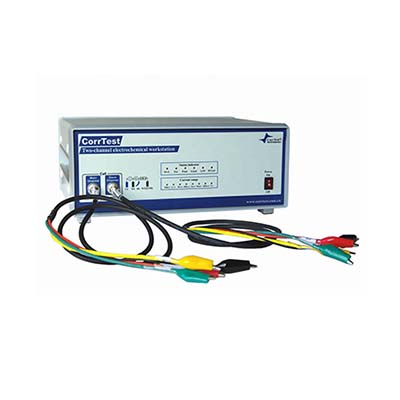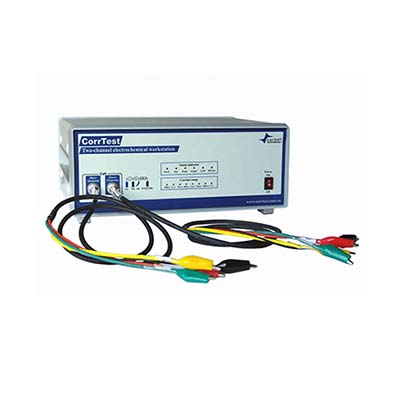CS2350 Bipotentiostat / Dual-channel electrochemical workstation
CS2350 bipotentiostat is developed from single channel CS350 potentiostat/galvanostat. There are two sets of built-in potentiostat /galvanostat. The two channels can conduct same or different experiments independently/simultaneously.
If the user only chooses to use the main channel, then CS2350 turns to be a CS350. Apart from all functions that CS350 single-channel potentiostat has, CS2350 can especially be used to do RRDE and HDT.
Applications
(1) Electrosythesis, electrodeposition (electroplating), anodic oxidation, electrolysis
(2) Oxygen reduction reaction(ORR), oxygen evolution reaction (OER), Hydrogen evolution reaction(HER), carbon dioxide reduction.
(3) Energy and materials (Li-ion battery,solar cell, fuel cell, supercapacitor), advanced function materials, and sensor.
(4) Corrosion behavior of metals, and anti-corrosion evaluation
(5) Fast evaluation of inhibitor, water quality stabilizer, coating, and cathodic protection efficiency.
Rotating ring-disk electrode(RRDE)
Oxidation/reduction reaction system: while measuring the polarization curve of disk electrode, keep the ring electrode at a fixed polarization potential, and thus detect the intermediates of reaction on the disk electrode. It becomes the typical fluid dynamicsmethod that detects reaction intermediates and studies electrode reaction mechanism.
Hydrogen diffusion test(HDT)
Two potentiostats are combined with Devnathan-Stachurski (dual cell). By measuring cathode hydrogen charging (the left cell) and anode oxidation current of hydrogen atoms (the right cell), it can further calculate the diffusion coefficient of hydrogen atoms in the metal and hydrogen flux.
SPECIFICATIONS
Support 2-, 3-, or 4-electrode system
Potential control range: Main Channel: ±10V
Slave Channel: ±10V
Current control range: ±2A
Potential control accuracy: 0.1%×full range±1mV
Current control accuracy: 0.1%×full range
Potential resolution: 10μV (>100Hz), 3μV (<10Hz)
Current sensitivity: 1pA
Rise time: <1μs (<10mA), <10μs (<2A)
Reference electrode input impedance: 1012Ω||20pF
Current range: 2A~2nA, 10 ranges
Compliance voltage: ±21V
Maximum current output: 2A
CV and LSV scan rate: 0.001mV~10,000V/s
CA and CC pulse width: 0.0001~65,000s
Current increment during scan: 1mA@1A/ms
Potential increment during scan: 0.076mV@1V/ms
SWV frequency: 0.001~100 kHz
DPV and NPV pulse width: 0.0001~1000s
AD data acquisition: 16bit@1 MHz,20bit@1 kHz
DA Resolution: 16bit, setup time:1μs
Minimum potential increment in CV: 0.075mV
IMP frequency: 10μHz~1MHz
Low-pass filters: Covering 8-decade
Potential and current range: Automatic
Electrochemical impedance Spectroscopy(EIS)
Signal generator
Frequency range: 10μHz~1MHz
AC amplitude: 0mV~2500mV
DC Bias: -10~+10V
Output impedance: 50Ω
Waveform: sine wave, triangular wave and square wave
Wave distortion: <1%
Scanning mode: Logarithmic/linear, increase/decrease
Maximum load capacitance: 1nF;Maximum load inductance:10μH
Signal analyzer
Integral time: 10ms or the longest time of a cycle
Maximum: 106cycles or 105s
Measurement delay: 0~105s
DC offset compensation
Potential automatic compensation range: -10V~+10V
Current compensation range: -1A~+1A
Bandwidth: 8-decade frequency range, Automatic and manual setting
PC and O/S requirement
Communications Interface: isolated Universal Serial Bus (USB 2.0)
Operating System: Windows 2000/NT/XP/7/8/10
SOFTWARE/METHODS OF CS2350
Main channel
Stable polarization:Open Circuit Potential (OCP), Potentiostatic (I-T Curve), Galvanostatic, Potentiodynamic (Tafel), Galvanodynamic,Sweep-Step Functions (SSF)
Transient polarization:Multi-Potential Steps, Multi-Current Steps, Potential Stair-Step (VSTEP), Galvanic Stair-Step (ISTEP)
Chrono Methods:Chronopotentiometry (CP), Chronoamperometry (CA), Chronocoulometry (CC)
Voltammetry:Cyclic Voltammetry (CV), Linear Sweep Voltammetry (LSV), Staircase Voltammetry (SCV), Differential Pulse Voltammetry (DPV), Normal Pulse Voltammetry (NPV), Square wave voltammetry (SWV), ACvoltammetry (ACV), Differential Normal Pulse Voltammetry (DNPV), 2nd Harmonic A. C. Voltammetry (SHACV), Fourier Transform AC Voltammetry(FTACV)
Stripping Voltammetry:Potentiostatic stripping, Linear stripping, Staircase stripping, Square wave stripping, Differential Pulse Voltammetry Stripping, Normal Pulse Voltammetry Stripping, Differential Normal Pulse Voltammetry Stripping.
Impedance:EIS vs Frequency (IMP), EIS vs Time (IMPT), EIS vs Potential (IMPE)
Corrosion test: Tafel plot, Electrochemical Noise (EN), Zero Resistance Ammeter (ZRA), Electrochemical Potentiokinetic Reactivation(EPR)
Battery test: Battery charge and discharge, Galvanostatic charge and discharge(GCD)
Bipotentiostat: Rotating ring-dick electrode(RRDE), Hydrogen Diffusion Test(HDT)
Extensions:Data Logger, Electrochemical stripping/deposition, Bulk electrolysis with Coulometry
Slave channel
Open Circuit Potential (OCP), Potentiostatic (I-T Curve), Galvanostatic, Potentiodynamic (Tafel), Galvanodynamic;
Multi-Potential Steps, Multi-Current Steps, Potential Stair-Step (VSTEP), Galvanic Stair-Step (ISTEP);
Cyclic Voltammetry (CV), Linear Sweep Voltammetry (LSV);
Tafel plot, Electrochemical Noise (EN), Zero Resistance Ammeter (ZRA);
Battery charge and discharge, Galvanostatic charge and discharge(GCD)












